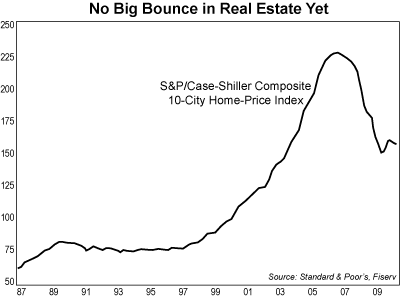| Home | About Us | Resources | Archive | Free Reports | Market Window |
Your Best Chance to Make 10 Times Your Money in the Stock MarketBy
Tuesday, May 4, 2010
"We've suddenly got some activity..."
My father lives in a wealthy suburb of New York, where many Wall Street bankers live. He's been trying to sell his house for nearly three years...
He's maintained the house and garden in perfect condition, he's hired the most aggressive realtors, and he's discounted his price. But the real estate market in his town is dead. He hasn't had a single interested buyer in all that time.
Last week, I spoke to my father. He still hasn't sold the house, but for the first time in years, he's been getting inquiries...
"It's like someone flipped a switch" he said. "And the engine's running again."
The Case-Shiller index is the easiest way to measure house prices. Famous economists Robert Shiller and Karl Case created it back in the 1980s to make it easier for insurance companies, ratings agencies, and mortgage lenders to evaluate house prices. Every month, they study data from the 10 largest cities in America and create a price index. They call this index the S&P/Case-Shiller Composite-10 Home Price Index.
 According to their data, house prices peaked in June 2006 and fell 34% to April 2009. The index then bounced weakly through September 2009. Last week, they released their latest report...
It shows real estate prices falling again. According to the Case-Shiller Composite, real estate prices have fallen every month since September 2009.
Here's the thing: It takes a couple of months for the statisticians to collect the data. The most recent report uses data collected through the end of February. In other words, the most recent Case-Shiller data is over two months out of date already.
My father's story suggests the market might have turned last month – in his town, anyway. More importantly, small bank stocks have bounced. Let me explain...
Last week, I sat down to analyze small-cap regional banks, and I counted 660 publicly traded regional bank stocks. Most of these stocks have market caps below $50 million... and dozens of them have market caps below $10 million.
These micro-cap regional banks are extremely leveraged to the price of real estate. All their assets are real estate loans. They use large quantities of debt to invest in these loans. When their assets decline in value, they squeeze the stock like a vice. Take a local bank I was studying the other day. It has a market cap of $5 million, but its most recent report shows $460 million in assets and $450 million in liabilities. Its assets only need to fall 1% or so from here to wipe out shareholders.
Due to this "compression effect" of leverage on small bank stocks, I've seen many regional banks lose 95% or more in their stock prices from the peak. Many of them are still trading at valuations that imply imminent bankruptcy.
I think this is a huge opportunity. Small cap bank stocks, by and large, did not rise in concert with the rest of the market back in March 2009. They kept falling – more in line with house prices.
I've been watching the stock prices of dozens of small regional banks... and this year, they've finally started rising.
I think it might be a sign the real estate market is about to turn higher... or even stabilize. (We won't know for sure until Case-Shiller's reports come out in May and June.)
If this is the start of the bounce in real estate, you can make a killing in small-cap regional bank stocks. Even if real estate is just stabilizing, the market will revalue bank assets, and leverage will work in the opposite direction. The stocks will soar. Many of these beaten-up banks will rise 1,000% or more.
This is a stock-picker's dream. These stocks are tiny, and the market is riddled with inefficiency. You can exploit these inefficiencies without having to compete with hedge funds or mutual funds, which won't bother with such small investments. But here's the best part...
Even if I'm wrong about the real estate market turning higher, you don't have much to lose. These banks are already priced for a worst-case scenario.
Good investing,
Tom
Further Reading:
So far, real estate is the only major asset class in America that hasn't shown any signs of recovery. Stocks, bonds, commodities... they've all soared. Real estate is even soaring in other countries. Last month, Tom showed you how property prices in London are nearing all time highs: Britain's Giant Property Bubble. The idea of homeownership as the American dream has taken a hit in the past couple years. That's not the only piece of "the dream" that's under assault. Right now, Steve is worried his son won't have the same opportunities he did growing up. Find out why – and his best ideas for protecting your kids' future – here: The Potential Death of the American Dream. Market NotesTHIS IS STILL OUR FAVORITE COMMODITY We've spent most of our "ink" over the past three months detailing how the government's giant "E-Z-Credit" program is pushing up the price of nearly every asset imaginable.
This makes life difficult for the contrarian trader, who looks for cheap, beaten-down assets to buy. One of the few ideas we can provide you is (still) check out natural gas.
Natural gas is a vital fuel that heats our homes and powers electrical plants. It also trades in a ratio to its energy cousin, crude oil. Sometimes oil gets cheap relative to gas. Sometimes gas gets cheap relative to oil. Last year, due to a big glut of new gas supply, this oil/gas ratio hit an extreme "boiling point" reading of 24:1. This is a super-cheap gas reading.
|
In The Daily Crux
Recent Articles
|

